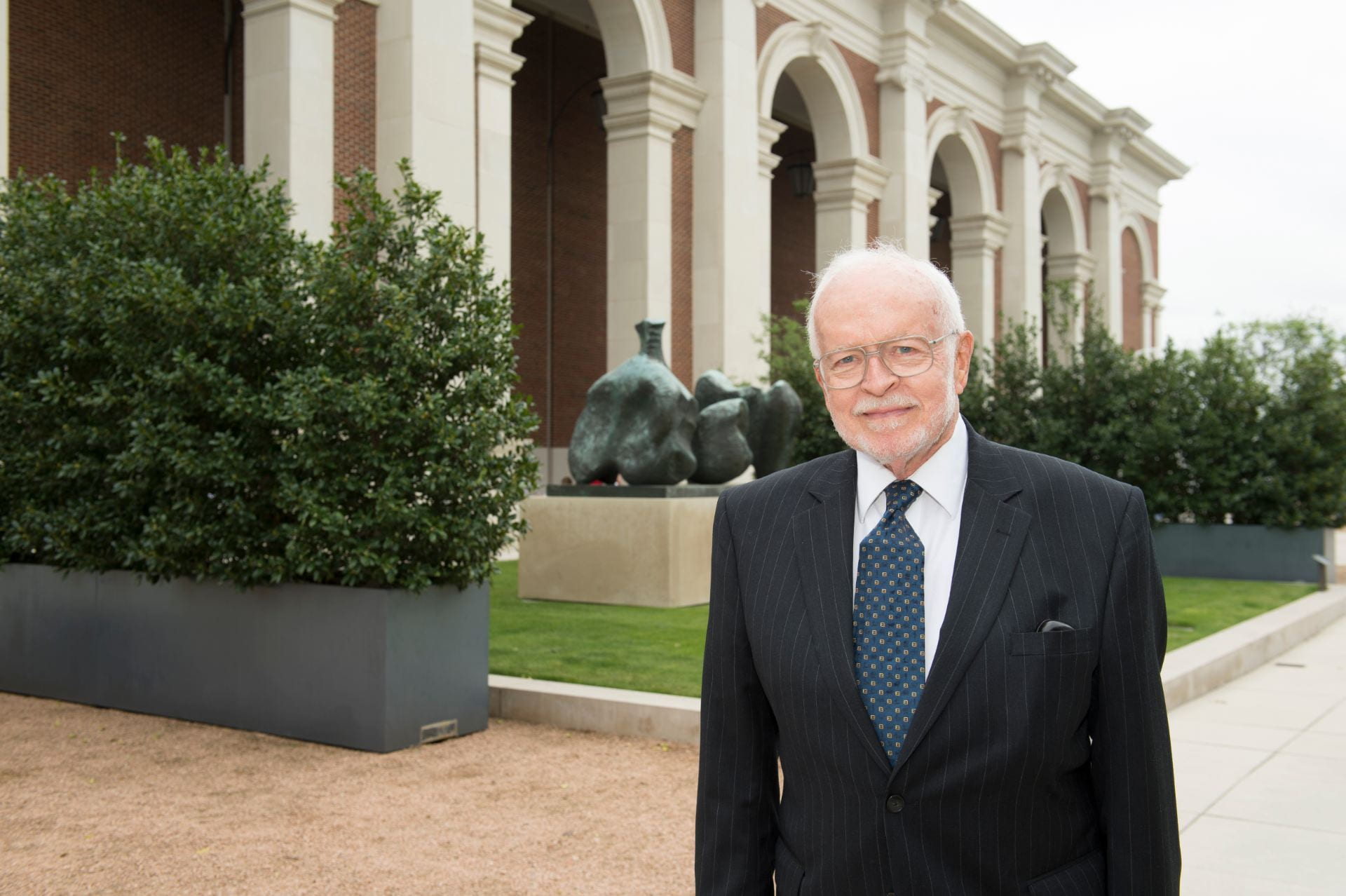by Jennifer Smart (M.A. ’19)
When John Lunsford passed away earlier this year, remembrances of the man who touched a wide swath of the Dallas art world were shared across North Texas.
As a curator at the Dallas Museum of Fine Arts (later the Dallas Museum of Art) from 1958 to 1986, he was an instrumental force in establishing the DMA as the world-class institution it is today. As director of the Meadows Museum from 1996 to 2001, he led the museum through an exciting period of change that culminated in the opening of its new, larger building on the SMU campus. Further, as adjunct associate professor in art history at the Meadows School of the Arts from 1968 to 1996, he taught more than a thousand students about a wide variety of non-Western art and connoisseurship. His former students and colleagues say his impact on them was memorable.
“John was already an institution when I arrived at SMU in 1974,” said Dr. Alessandra Comini, professor emerita of art history. “His geniality and breadth of knowledge were delightful and his appetite for the new was ferocious.”
Lunsford is remembered as an enthusiastic, kind, and highly professional leader, but most of all for his commitment to simply engaging with the art, especially in an age when the museum world was becoming increasingly specialized and academic. “John was a true object lover who enjoyed looking at art and scrutinizing every detail,” said Mark Roglán, now the Linda P. and William A. Custard Director of the Meadows Museum, who joined the museum as interim curator just as Lunsford’s time as director was coming to an end. “It was always wonderful to hear him talk about art and listen to all the connections he could make across different cultures and styles. He was an astute connoisseur and walking cultural encyclopedia.”
Gregory Warden, SMU professor emeritus of art history and president of Franklin University Switzerland, took over as interim director of the Meadows Museum in 2001 when Lunsford stepped down. He also remembers Lunsford’s commitment to connoisseurship. “I had high regard for his curatorial eye,” he said. “And I appreciated his professionalism and calm demeanor in dealing with a wide variety of personalities.”
Michael Grauer, a curator, teacher, and expert on Texas art, was a student of Lunsford’s in the late 1980s. Although his teaching focused on non-Western art, Lunsford, a Dallas native, had an impressive depth of knowledge about historic Texas art and served as advisor for Grauer’s master’s thesis on the Texas painter Frank Reaugh. Grauer echoed the oft-repeated remembrance of Lunsford’s commitment to connoisseurship, and remembers Lunsford’s class on the subject as the best one he took when he was a student at SMU. “In the class, John tried to teach a bunch of budding art historians that art was more about looking and seeing than about documentation,” he said. “The lessons I learned were mainly that you could find all the documents in the world surrounding a work of art, but that doesn’t make it good or great. We had to learn to train our eyes to be discriminating and listen to our gut, our visceral response to a work of art.”
Bridget Marx, associate director and curator of exhibitions at the Meadows Museum, was a graduate student when she began working with Lunsford as a teaching assistant for Dr. Pamela Patton, the Meadows Museum’s curator during Lunsford’s tenure as director. “It was an exciting time to be a part of the Meadows Museum; not only was the new building being developed and constructed, the collection itself was being prepared for temporary exhibition in Spain,” she said. “John would joke that we were moving across the street, via Madrid.” She recalled Lunsford as a patient and generous leader who “never missed the opportunity to grow and encourage the love of museum work in a young student.”
His commitment to the mentorship of young students and professionals is echoed by another former pupil, Kathy Windrow, who earned three degrees at SMU under Lunsford’s tutelage and now teaches in the Meadows Division of Theatre and directs the SMU-in-Italy Arts and Culture program. She remembered Lunsford as regularly going out of his way to offer encouragement and support, sometimes even financial help, to students of all backgrounds. “Students followed him like groupies,” she recalled. “He was our guide through dangerous intellectual terrain, devoted to the work of teaching, his students, and above all to the works of art.”
“He was extremely confident, but never arrogant, about what he knew,” Grauer said. “He was always learning. His example to always seek to know and experience more is something I have never forgotten. He also ensured we knew that all art making is spiritual and that spirit inhabited and was inculcated—he would love that I used that word right there!— in all things.”
Lunsford’s legacy at SMU and especially at the Meadows Museum lives on. In addition to overseeing the Meadows permanent collection installment in its new home and the welcoming of the king and queen of Spain to the SMU campus for the building’s grand opening, he also secured the purchase of an El Greco canvas, Saint Francis Kneeling in Meditation, for the museum, and handled the commission of the monumental Santiago Calatrava sculpture, Wave, which today greets visitors at the entrance of the SMU campus.

